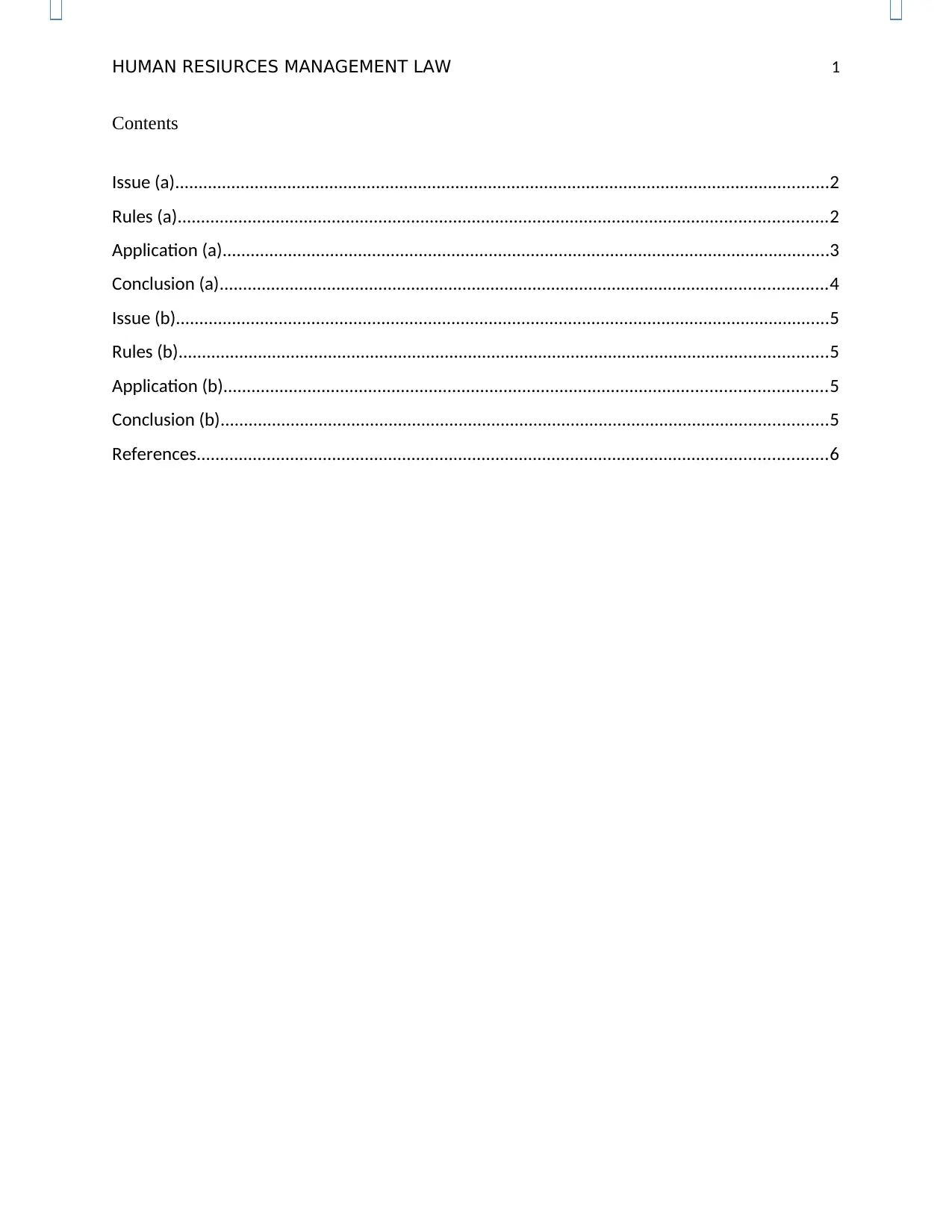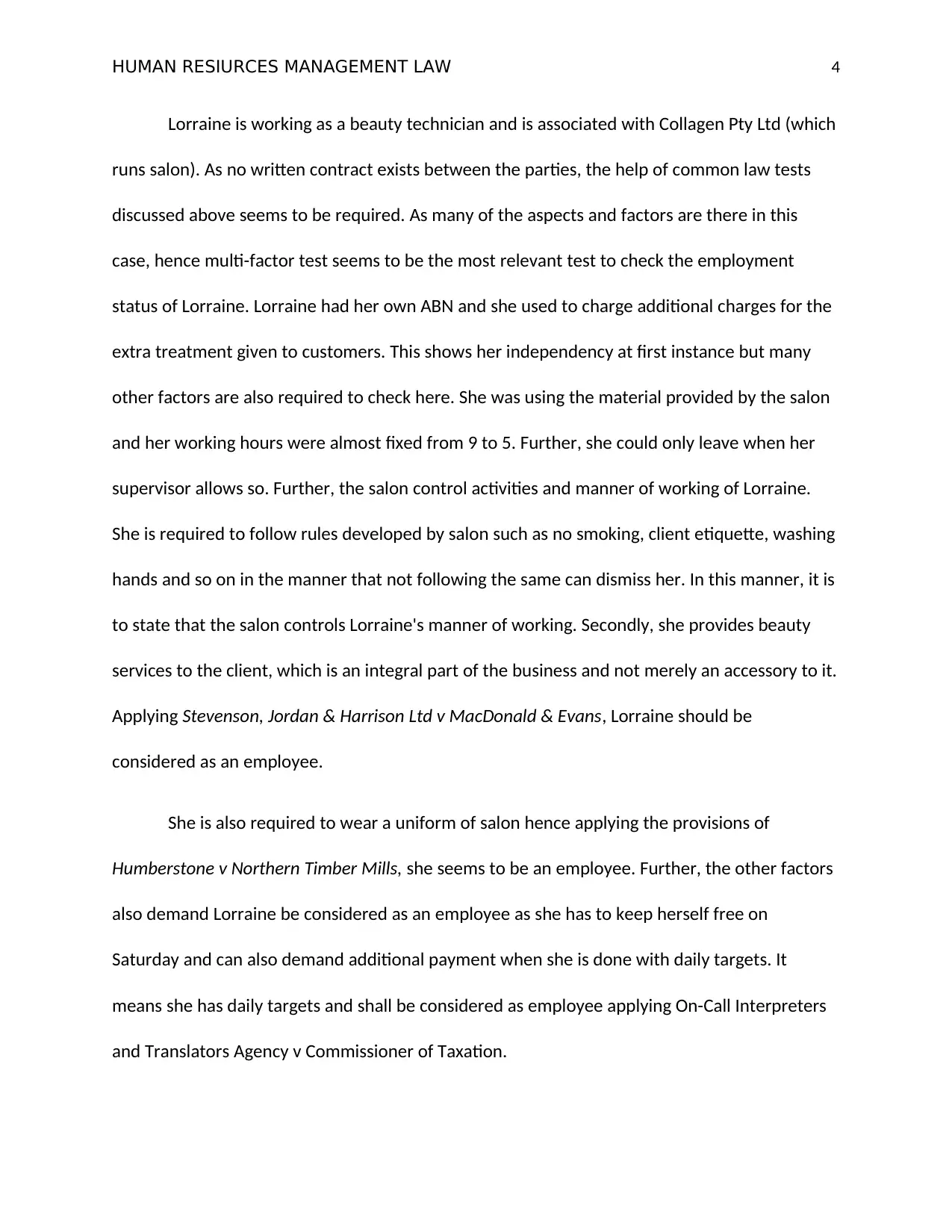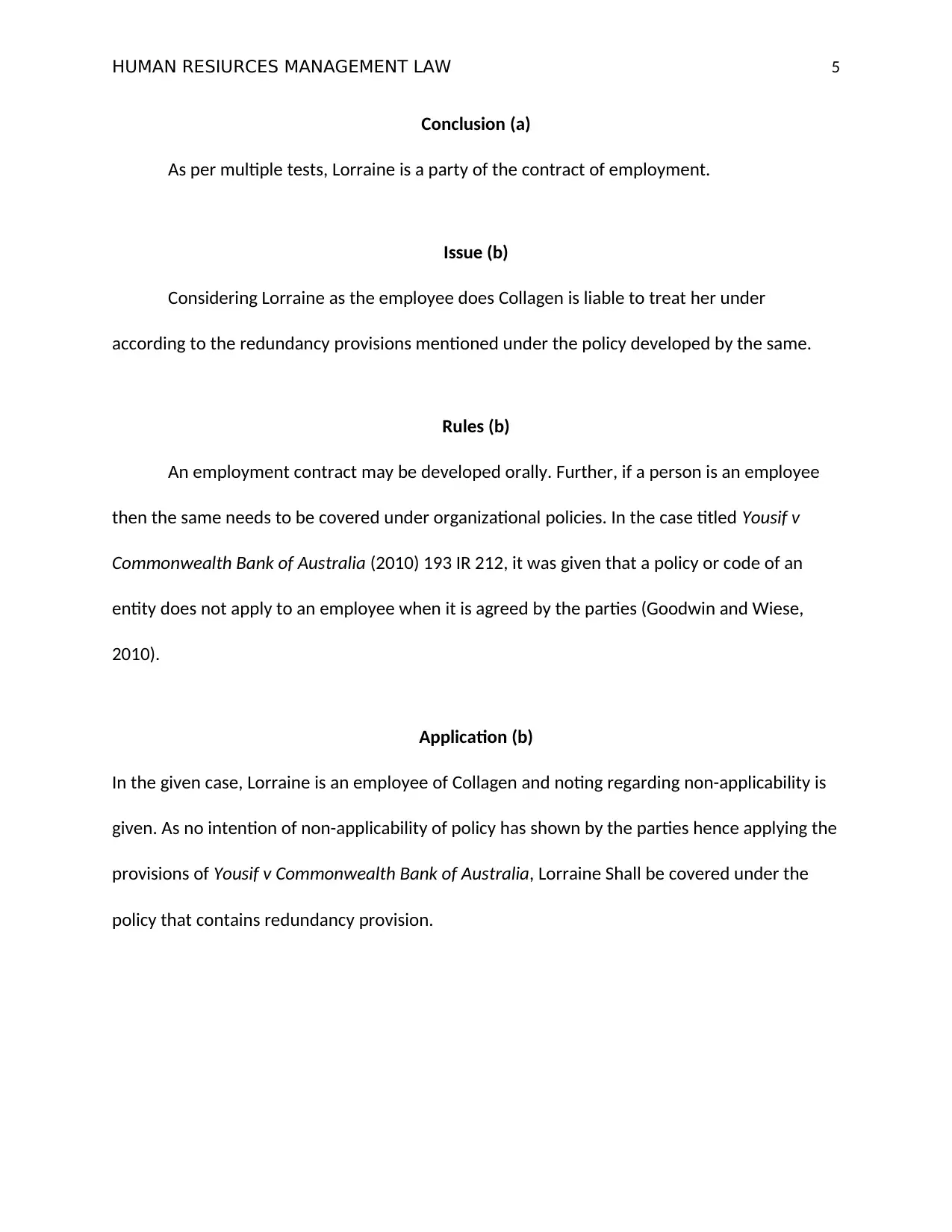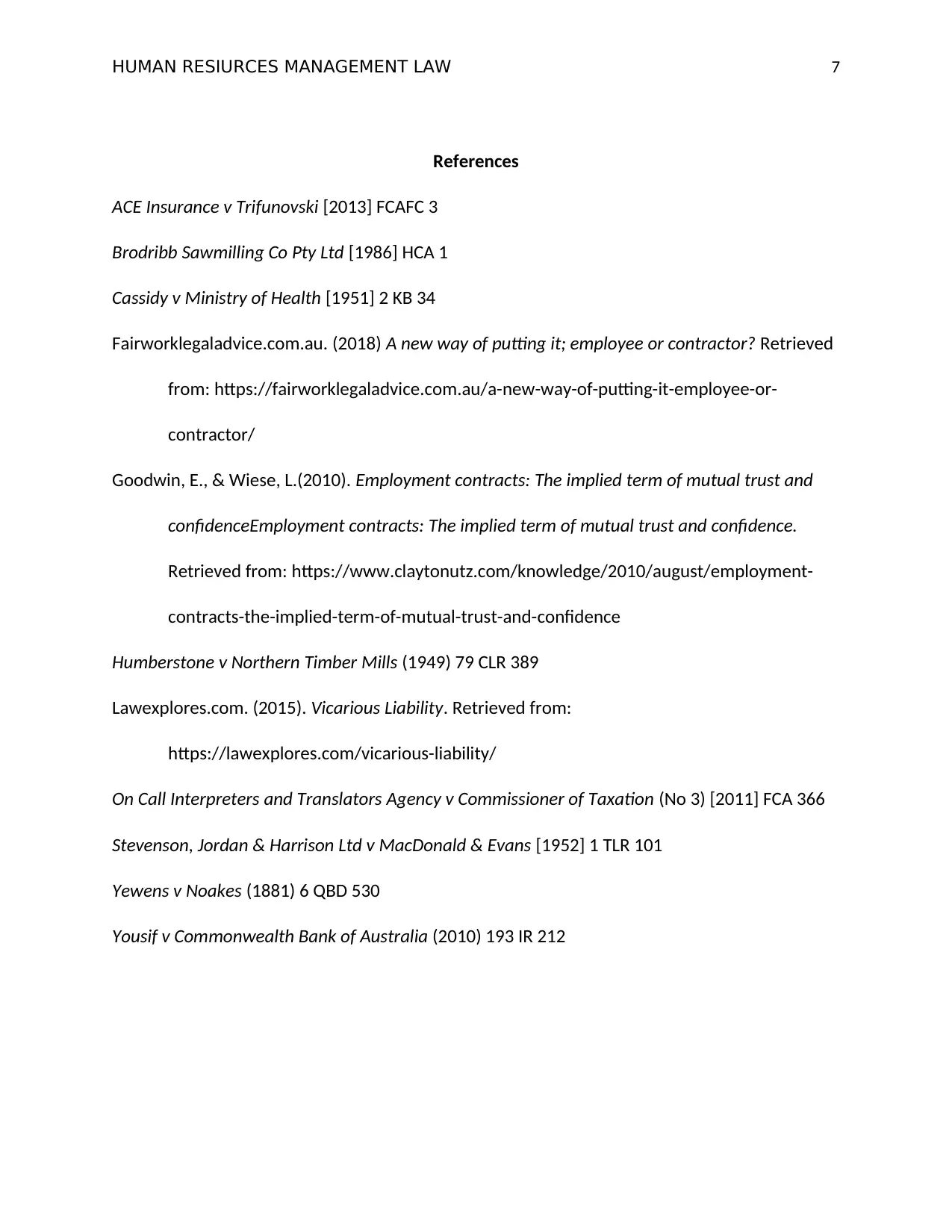HR Law Assignment: Employee or Contractor - Case Study Analysis
VerifiedAdded on 2022/11/17
|8
|1402
|455
Homework Assignment
AI Summary
This assignment analyzes the employment status of Lorraine, a beauty technician associated with Collagen Pty Ltd. The paper examines whether Lorraine should be classified as an employee or an independent contractor, considering the absence of a written contract and applying common law tests, particularly the multi-factor test. The analysis considers factors such as Lorraine's ABN, working hours, control by the salon, use of salon materials, and the integration of her services into the business. The paper concludes that, based on these factors and relevant case law, Lorraine is likely an employee. Furthermore, it addresses whether Collagen is liable to treat Lorraine under its redundancy provisions, concluding that she is covered by the policy due to her employee status and the absence of an agreement to the contrary. The assignment references several key cases to support its arguments.

Running head: HUMAN RESIURCES MANAGEMENT LAW
0
Human Resource Management Law
10/10/2019
Student’s Name
0
Human Resource Management Law
10/10/2019
Student’s Name
Paraphrase This Document
Need a fresh take? Get an instant paraphrase of this document with our AI Paraphraser

HUMAN RESIURCES MANAGEMENT LAW 1
Contents
Issue (a)............................................................................................................................................2
Rules (a)...........................................................................................................................................2
Application (a)..................................................................................................................................3
Conclusion (a)..................................................................................................................................4
Issue (b)............................................................................................................................................5
Rules (b)...........................................................................................................................................5
Application (b).................................................................................................................................5
Conclusion (b)..................................................................................................................................5
References.......................................................................................................................................6
Contents
Issue (a)............................................................................................................................................2
Rules (a)...........................................................................................................................................2
Application (a)..................................................................................................................................3
Conclusion (a)..................................................................................................................................4
Issue (b)............................................................................................................................................5
Rules (b)...........................................................................................................................................5
Application (b).................................................................................................................................5
Conclusion (b)..................................................................................................................................5
References.......................................................................................................................................6

HUMAN RESIURCES MANAGEMENT LAW 2
Issue (a)
The issue is to check the employment status of Lorraine. Whether the same should be
considered as an employee or as an independent contractor.
Rules (a)
Common-Law gives some tests using that employment status can be checked. These
tests have been given in the decisions of different cases. These tests are discussed in the
following section.
The very first test has been granted in the decision of Yewens v Noakes (1881) 6 QBD
530 and known as a control test. As the name shows, under this test, the control level of one
party over another determines whether the person is acting in the capacity of an employee or
whether the same is an independent contractor (Lawexplores.com, 2015). As per rules of this
test a person is treated as an employee in those cases where the other person decides the
manner of working in terms of shift hours, uniform and organizational rules.
The second test provided by common law is the integration test. Under this test, courts
check that how a person is integrated into the dealings of an organization. The test has been
used and confirmed in the case of Cassidy v Ministry of Health [1951] 2 KB 34. Further in the
case of Stevenson, Jordan & Harrison Ltd v MacDonald & Evans [1952] 1 TLR 101 the test again
has been used where the court confirmed that if a person is an integral part of the entity then
in such a situation the same is treated as an employee and not an independent contractor.
Issue (a)
The issue is to check the employment status of Lorraine. Whether the same should be
considered as an employee or as an independent contractor.
Rules (a)
Common-Law gives some tests using that employment status can be checked. These
tests have been given in the decisions of different cases. These tests are discussed in the
following section.
The very first test has been granted in the decision of Yewens v Noakes (1881) 6 QBD
530 and known as a control test. As the name shows, under this test, the control level of one
party over another determines whether the person is acting in the capacity of an employee or
whether the same is an independent contractor (Lawexplores.com, 2015). As per rules of this
test a person is treated as an employee in those cases where the other person decides the
manner of working in terms of shift hours, uniform and organizational rules.
The second test provided by common law is the integration test. Under this test, courts
check that how a person is integrated into the dealings of an organization. The test has been
used and confirmed in the case of Cassidy v Ministry of Health [1951] 2 KB 34. Further in the
case of Stevenson, Jordan & Harrison Ltd v MacDonald & Evans [1952] 1 TLR 101 the test again
has been used where the court confirmed that if a person is an integral part of the entity then
in such a situation the same is treated as an employee and not an independent contractor.
⊘ This is a preview!⊘
Do you want full access?
Subscribe today to unlock all pages.

Trusted by 1+ million students worldwide

HUMAN RESIURCES MANAGEMENT LAW 3
The last common law test to discuss here is the multi-factor test. Court founds some
issues with control test and integrated test as they only focus on one or two factors hence in
today's world courts use multiple tests (multi factors test). The earlier two tests i.e. control test
and integration test has been absorbed into a multifactor test.
Under this test, courts check and review many of the factors in a relationship between
two persons and then make a conclusion. Every factor has a crucial role in determining the
employment status of a person. The multifactor test has been given in the decision of Stevens v
Brodribb Sawmilling Co Pty Ltd [1986] HCA 1. These factors have been given while deciding on
different cases. For instance, in the case titled as ACE Insurance v Trifunovski [2013] FCAFC 3, it
was given that a person considers as an employee if the same needs to attend a training offered
by the other person. Further the case of On Call Interpreters and Translators Agency v
Commissioner of Taxation (No 3) [2011] FCA 366 stated that if a person is required to work as
per the instruction of others then also such person is treated as an employee of the other
person who gives such instructions. Humberstone v Northern Timber Mills (1949) 79 CLR 389 is
another important case to discuss here where it was given that compulsion to wear the uniform
of organization confirms the existence of an employer-employee relationship
(Fairworklegaladvice.com.au, 2018).
Hence, to state that using these three tests, courts may decide the employment status
of a person.
Application (a)
The last common law test to discuss here is the multi-factor test. Court founds some
issues with control test and integrated test as they only focus on one or two factors hence in
today's world courts use multiple tests (multi factors test). The earlier two tests i.e. control test
and integration test has been absorbed into a multifactor test.
Under this test, courts check and review many of the factors in a relationship between
two persons and then make a conclusion. Every factor has a crucial role in determining the
employment status of a person. The multifactor test has been given in the decision of Stevens v
Brodribb Sawmilling Co Pty Ltd [1986] HCA 1. These factors have been given while deciding on
different cases. For instance, in the case titled as ACE Insurance v Trifunovski [2013] FCAFC 3, it
was given that a person considers as an employee if the same needs to attend a training offered
by the other person. Further the case of On Call Interpreters and Translators Agency v
Commissioner of Taxation (No 3) [2011] FCA 366 stated that if a person is required to work as
per the instruction of others then also such person is treated as an employee of the other
person who gives such instructions. Humberstone v Northern Timber Mills (1949) 79 CLR 389 is
another important case to discuss here where it was given that compulsion to wear the uniform
of organization confirms the existence of an employer-employee relationship
(Fairworklegaladvice.com.au, 2018).
Hence, to state that using these three tests, courts may decide the employment status
of a person.
Application (a)
Paraphrase This Document
Need a fresh take? Get an instant paraphrase of this document with our AI Paraphraser

HUMAN RESIURCES MANAGEMENT LAW 4
Lorraine is working as a beauty technician and is associated with Collagen Pty Ltd (which
runs salon). As no written contract exists between the parties, the help of common law tests
discussed above seems to be required. As many of the aspects and factors are there in this
case, hence multi-factor test seems to be the most relevant test to check the employment
status of Lorraine. Lorraine had her own ABN and she used to charge additional charges for the
extra treatment given to customers. This shows her independency at first instance but many
other factors are also required to check here. She was using the material provided by the salon
and her working hours were almost fixed from 9 to 5. Further, she could only leave when her
supervisor allows so. Further, the salon control activities and manner of working of Lorraine.
She is required to follow rules developed by salon such as no smoking, client etiquette, washing
hands and so on in the manner that not following the same can dismiss her. In this manner, it is
to state that the salon controls Lorraine's manner of working. Secondly, she provides beauty
services to the client, which is an integral part of the business and not merely an accessory to it.
Applying Stevenson, Jordan & Harrison Ltd v MacDonald & Evans, Lorraine should be
considered as an employee.
She is also required to wear a uniform of salon hence applying the provisions of
Humberstone v Northern Timber Mills, she seems to be an employee. Further, the other factors
also demand Lorraine be considered as an employee as she has to keep herself free on
Saturday and can also demand additional payment when she is done with daily targets. It
means she has daily targets and shall be considered as employee applying On-Call Interpreters
and Translators Agency v Commissioner of Taxation.
Lorraine is working as a beauty technician and is associated with Collagen Pty Ltd (which
runs salon). As no written contract exists between the parties, the help of common law tests
discussed above seems to be required. As many of the aspects and factors are there in this
case, hence multi-factor test seems to be the most relevant test to check the employment
status of Lorraine. Lorraine had her own ABN and she used to charge additional charges for the
extra treatment given to customers. This shows her independency at first instance but many
other factors are also required to check here. She was using the material provided by the salon
and her working hours were almost fixed from 9 to 5. Further, she could only leave when her
supervisor allows so. Further, the salon control activities and manner of working of Lorraine.
She is required to follow rules developed by salon such as no smoking, client etiquette, washing
hands and so on in the manner that not following the same can dismiss her. In this manner, it is
to state that the salon controls Lorraine's manner of working. Secondly, she provides beauty
services to the client, which is an integral part of the business and not merely an accessory to it.
Applying Stevenson, Jordan & Harrison Ltd v MacDonald & Evans, Lorraine should be
considered as an employee.
She is also required to wear a uniform of salon hence applying the provisions of
Humberstone v Northern Timber Mills, she seems to be an employee. Further, the other factors
also demand Lorraine be considered as an employee as she has to keep herself free on
Saturday and can also demand additional payment when she is done with daily targets. It
means she has daily targets and shall be considered as employee applying On-Call Interpreters
and Translators Agency v Commissioner of Taxation.

HUMAN RESIURCES MANAGEMENT LAW 5
Conclusion (a)
As per multiple tests, Lorraine is a party of the contract of employment.
Issue (b)
Considering Lorraine as the employee does Collagen is liable to treat her under
according to the redundancy provisions mentioned under the policy developed by the same.
Rules (b)
An employment contract may be developed orally. Further, if a person is an employee
then the same needs to be covered under organizational policies. In the case titled Yousif v
Commonwealth Bank of Australia (2010) 193 IR 212, it was given that a policy or code of an
entity does not apply to an employee when it is agreed by the parties (Goodwin and Wiese,
2010).
Application (b)
In the given case, Lorraine is an employee of Collagen and noting regarding non-applicability is
given. As no intention of non-applicability of policy has shown by the parties hence applying the
provisions of Yousif v Commonwealth Bank of Australia, Lorraine Shall be covered under the
policy that contains redundancy provision.
Conclusion (a)
As per multiple tests, Lorraine is a party of the contract of employment.
Issue (b)
Considering Lorraine as the employee does Collagen is liable to treat her under
according to the redundancy provisions mentioned under the policy developed by the same.
Rules (b)
An employment contract may be developed orally. Further, if a person is an employee
then the same needs to be covered under organizational policies. In the case titled Yousif v
Commonwealth Bank of Australia (2010) 193 IR 212, it was given that a policy or code of an
entity does not apply to an employee when it is agreed by the parties (Goodwin and Wiese,
2010).
Application (b)
In the given case, Lorraine is an employee of Collagen and noting regarding non-applicability is
given. As no intention of non-applicability of policy has shown by the parties hence applying the
provisions of Yousif v Commonwealth Bank of Australia, Lorraine Shall be covered under the
policy that contains redundancy provision.
⊘ This is a preview!⊘
Do you want full access?
Subscribe today to unlock all pages.

Trusted by 1+ million students worldwide

HUMAN RESIURCES MANAGEMENT LAW 6
Conclusion (b)
No matter that a written contract does not exist between the parties, if Lorraine is an
employee then Collagen is liable to make her payment as per the redundancy provisions of
policy developed by it.
Conclusion (b)
No matter that a written contract does not exist between the parties, if Lorraine is an
employee then Collagen is liable to make her payment as per the redundancy provisions of
policy developed by it.
Paraphrase This Document
Need a fresh take? Get an instant paraphrase of this document with our AI Paraphraser

HUMAN RESIURCES MANAGEMENT LAW 7
References
ACE Insurance v Trifunovski [2013] FCAFC 3
Brodribb Sawmilling Co Pty Ltd [1986] HCA 1
Cassidy v Ministry of Health [1951] 2 KB 34
Fairworklegaladvice.com.au. (2018) A new way of putting it; employee or contractor? Retrieved
from: https://fairworklegaladvice.com.au/a-new-way-of-putting-it-employee-or-
contractor/
Goodwin, E., & Wiese, L.(2010). Employment contracts: The implied term of mutual trust and
confidenceEmployment contracts: The implied term of mutual trust and confidence.
Retrieved from: https://www.claytonutz.com/knowledge/2010/august/employment-
contracts-the-implied-term-of-mutual-trust-and-confidence
Humberstone v Northern Timber Mills (1949) 79 CLR 389
Lawexplores.com. (2015). Vicarious Liability. Retrieved from:
https://lawexplores.com/vicarious-liability/
On Call Interpreters and Translators Agency v Commissioner of Taxation (No 3) [2011] FCA 366
Stevenson, Jordan & Harrison Ltd v MacDonald & Evans [1952] 1 TLR 101
Yewens v Noakes (1881) 6 QBD 530
Yousif v Commonwealth Bank of Australia (2010) 193 IR 212
References
ACE Insurance v Trifunovski [2013] FCAFC 3
Brodribb Sawmilling Co Pty Ltd [1986] HCA 1
Cassidy v Ministry of Health [1951] 2 KB 34
Fairworklegaladvice.com.au. (2018) A new way of putting it; employee or contractor? Retrieved
from: https://fairworklegaladvice.com.au/a-new-way-of-putting-it-employee-or-
contractor/
Goodwin, E., & Wiese, L.(2010). Employment contracts: The implied term of mutual trust and
confidenceEmployment contracts: The implied term of mutual trust and confidence.
Retrieved from: https://www.claytonutz.com/knowledge/2010/august/employment-
contracts-the-implied-term-of-mutual-trust-and-confidence
Humberstone v Northern Timber Mills (1949) 79 CLR 389
Lawexplores.com. (2015). Vicarious Liability. Retrieved from:
https://lawexplores.com/vicarious-liability/
On Call Interpreters and Translators Agency v Commissioner of Taxation (No 3) [2011] FCA 366
Stevenson, Jordan & Harrison Ltd v MacDonald & Evans [1952] 1 TLR 101
Yewens v Noakes (1881) 6 QBD 530
Yousif v Commonwealth Bank of Australia (2010) 193 IR 212
1 out of 8
Related Documents
Your All-in-One AI-Powered Toolkit for Academic Success.
+13062052269
info@desklib.com
Available 24*7 on WhatsApp / Email
![[object Object]](/_next/static/media/star-bottom.7253800d.svg)
Unlock your academic potential
Copyright © 2020–2025 A2Z Services. All Rights Reserved. Developed and managed by ZUCOL.





